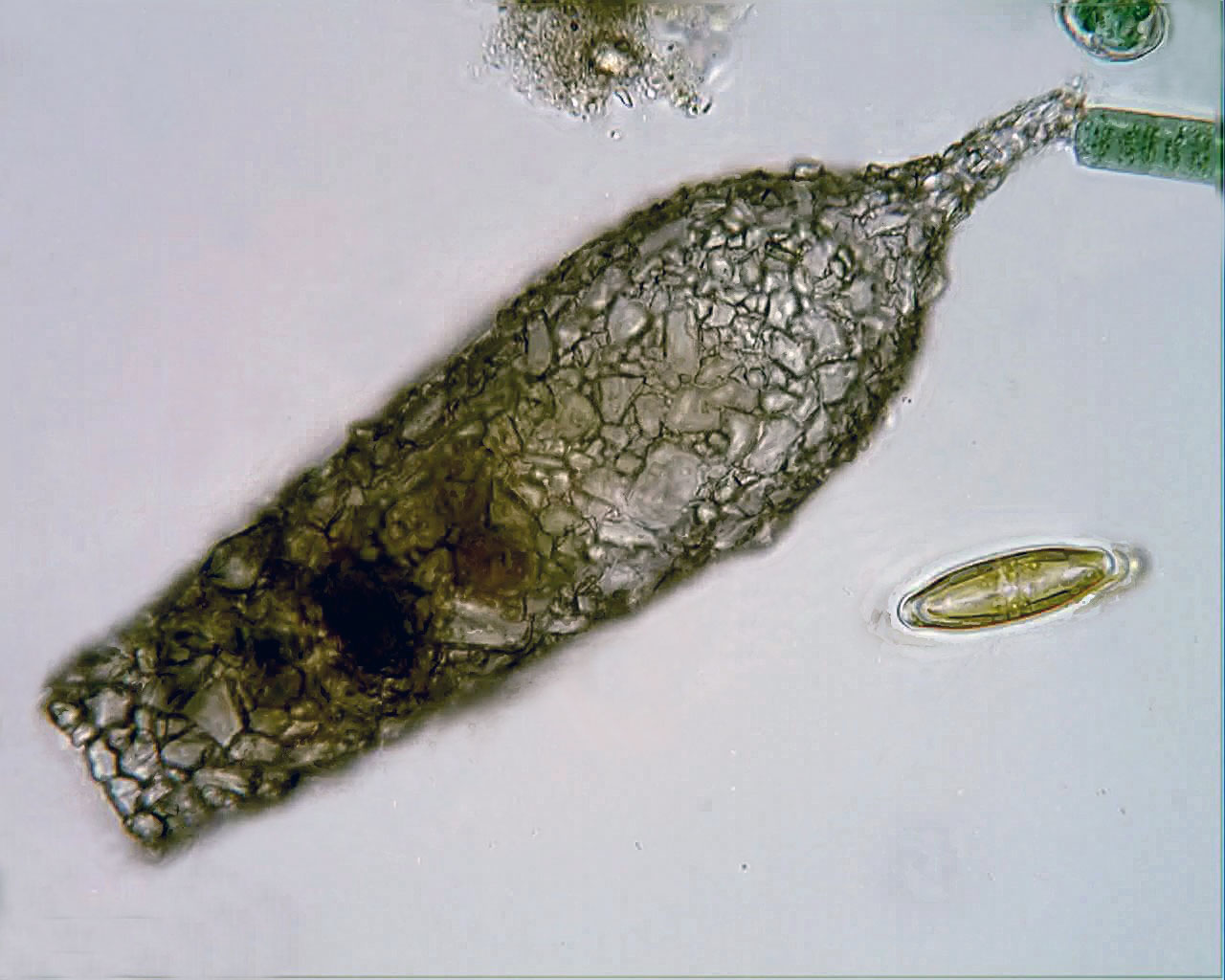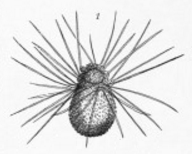|
Thecamoebians
Testate amoebae (formerly thecamoebians, Testacea or Thecamoeba) are a polyphyletic group of unicellular amoeboid protists, which differ from naked amoebae in the presence of a test that partially encloses the cell, with an aperture from which the pseudopodia emerge, that provides the amoeba with shelter from predators and environmental conditions. The test of some species is produced entirely by the amoeba and may be organic, siliceous or calcareous depending on the species (autogenic tests), whereas in other cases the test is made up of particles of sediment collected by the amoeba which are then agglutinated together by secretions from within the cell (xenogenic tests). A few taxa (Hyalospheniidae) can build either type, depending on the circumstances and availability of foreign material. The assemblage referred to as "testate amoebae" is actually composed of several, unrelated groups of organisms. However, some features they all share that have been used to group them togeth ... [...More Info...] [...Related Items...] OR: [Wikipedia] [Google] [Baidu] |
Difflugia Acuminata
''Difflugia'' is the largest genus of Arcellinida, one of several groups of Tubulinea within the eukaryote supergroup Amoebozoa. Arcellinida species produce shells or tests from mineral particles or biogenic elements (e.g. diatom frustules) and are thus commonly referred to as testate amoebae or shelled amoebae. ''Difflugia'' are particularly common in marshes and other freshwater habitats. History The genus ''Difflugia'' was initially discovered in 1815 by L, Leclerc, but its infra-generic classification as a group is still unclear. The genus ''Difflugia'' is the oldest and most diverse of the testate amoebae. It contains more than 300 species and countless subspecies since even minor differences in morphology result in classification as a new species. In 1958, Gauthier-Lièvre and Thomas divided the genus into 10 groups depending on difference in shell morphology. These 10 groups are based on a survey conducted of the African species of ''Difflugia'' The 10 shell shape c ... [...More Info...] [...Related Items...] OR: [Wikipedia] [Google] [Baidu] |
Tubulinea
The Tubulinea are a major grouping of Amoebozoa, including most of the more familiar amoebae genera like ''Amoeba'', '' Arcella'', '' Difflugia'' and '' Hartmannella''. Characteristics During locomotion most Tubulinea have a roughly cylindrical form or produce numerous cylindrical pseudopods. Each cylinder advances by a single central stream of cytoplasm, granular in appearance, and has no subpseudopodia. This distinguishes them from other amoeboid groups, although in some members this is not the normal type of locomotion. Classification This class was anticipated by some biologists such as Jahn, who grouped all amoebae with granular pseudopodia together, but most split the lobose amoebae into testate Testacealobosia and naked Gymnamoebia. These latter are polyphyletic, but molecular trees by Bolivar ''et al.'' identified a core monophyletic subgroup. Subsequent studies showed the testate lobose amoebae belong to the same group, which was thus renamed Lobosea ''sensu stric ... [...More Info...] [...Related Items...] OR: [Wikipedia] [Google] [Baidu] |
Difflugia
''Difflugia'' is the largest genus of Arcellinida, one of several groups of Tubulinea within the eukaryote supergroup Amoebozoa. Arcellinida species produce shells or tests from mineral particles or biogenic elements (e.g. diatom frustules) and are thus commonly referred to as testate amoebae or shelled amoebae. ''Difflugia'' are particularly common in marshes and other freshwater habitats. History The genus ''Difflugia'' was initially discovered in 1815 by L, Leclerc, but its infra-generic classification as a group is still unclear. The genus ''Difflugia'' is the oldest and most diverse of the testate amoebae. It contains more than 300 species and countless subspecies since even minor differences in morphology result in classification as a new species. In 1958, Gauthier-Lièvre and Thomas divided the genus into 10 groups depending on difference in shell morphology. These 10 groups are based on a survey conducted of the African species of ''Difflugia'' The 10 shell shape cl ... [...More Info...] [...Related Items...] OR: [Wikipedia] [Google] [Baidu] |
Cucurbitella (amoeba)
''Cucurbitella'' may refer to the following: * Cucurbitella (plant), ''Cucurbitella'' (plant), a genus of flowering plants * Cucurbitella (amoeba), ''Cucurbitella'' (amoeba), a genus of amoebae {{Disambiguation ... [...More Info...] [...Related Items...] OR: [Wikipedia] [Google] [Baidu] |
Centropyxis
''Centropyxis'' is a genus of lobose testate amoebae (Amoebozoa), including the species ''Centropyxis aculeata''. References External links Descriptions and pictures of Centropyxis ' at Microworld Amoebozoa genera Taxa named by Johann Philip Emil Friedrich Stein {{Amoebozoa-stub ... [...More Info...] [...Related Items...] OR: [Wikipedia] [Google] [Baidu] |
Diplochlamys (protist)
Corycidia (alternatively spelt Corycida) is a clade of amoeboid protists within the eukaryotic supergroup Amoebozoa. It contains all amoebae of the families Microcoryciidae, which was previously regarded as Arcellinida (an order of testate amoebae), and Trichosphaeriidae, which contains the sole genus '' Trichosphaerium''. Taxonomy Corycidia is defined as the least inclusive clade containing '' Amphizonella'', '' Diplochlamys'' and '' Trichosphaerium''. It was discovered in 2017 through a phylogenomic study by Senghuo Kang and coauthors, published in the journal ''Molecular Biology and Evolution''. It is supported by independent analyses. As of 2019, it is accepted by the International Society of Protistologists as part of the modern cladistic classification of eukaryotes, although under the alternative spelling Corycida. The name Corycidia is derived , referring to the "leathery" test that members of the clade have. Evolution Corycidia is located in the eukaryotic super ... [...More Info...] [...Related Items...] OR: [Wikipedia] [Google] [Baidu] |
Cryptodifflugia
''Cryptodifflugia'' is a genus of arcellinid testate amoebae. It contains all the species previously grouped as the genus ''Difflugiella'', which is now a synonym of ''Cryptodifflugia''. Description ''Cryptodifflugia'' species are characterized by a shell with an oval egg-like shape with a short neck. Their surface is either smooth or adhering foreign particles. The shell can be colorless, yellow or brown, composed of an outer proteinaceous material that is usually lined. The shell's aperture is terminal, and has either a circular or an oval shape. They present pseudopods in the form of ectoplasmic anastomosing reticulopods, i.e. like fine threads that can branch or anastomose (meaning they can form links with each other) to create a dense network. Classification The classification of the genus, as revised in 2017, identifies 23 species along with some subspecies: *'' Cryptodifflugia angulata'' Playfair, 1917 – Australia *'' Cryptodifflugia angusta'' (Schönborn, 1965) Page ... [...More Info...] [...Related Items...] OR: [Wikipedia] [Google] [Baidu] |
Apodera
''Apodera'' is a genus of amoeboid protists belonging to the family Hyalospheniidae, a group of shelled amoebae. Their shells, or tests, are lageniform with a clear constriction that separates the neck from the body. Characteristics ''Apodera'' are testate amoebae, protists with a cell body that generates pseudopodia and is enclosed within a test or shell. Their shells are composed of mineral material that is xenosomic, i.e. obtained from their prey, which are euglyphid amoebae. This is a common trait among the Hyalospheniidae, to which ''Apodera'' belongs. In particular, ''Apodera'' shells are uniquely distinctive by the presence of a clear, deep constriction that separates the neck from the body. Systematics ''Apodera'' is a genus first proposed by Jung in 1942 without designating a type. Later, in 1961, the genus was validated by micropaleontologists Loeblich and Tappan. It is closely related to the genera '' Alocodera'' and '' Padaungiella'' by the similar shape ... [...More Info...] [...Related Items...] OR: [Wikipedia] [Google] [Baidu] |
SAR Supergroup
SAR is a highly diverse clade of eukaryotes, often considered a supergroup, that includes stramenopiles (heterokonts), alveolates, and rhizarians. It is a node-based taxon (under the Sar name), including all descendants of the three groups' last common ancestor, and comprises most of the now-rejected Chromalveolata. Their sister group has been found to be telonemids, with which they make up the TSAR clade. Harosa is sometimes used synonymously with TSAR. Etymology The name SAR is an acronym derived from the first letters of its three constituent clades; it has been alternatively spelled RAS. The term Harosa (at the subkingdom level) has also been used, with Stramenopiles replaced by its synonym Heterokonta in this variant of the acronym. History of discovery Before the discovery of the SAR supergroup, stramenopiles and alveolates were classified in the supergroup Chromalveolata alongside haptophytes and cryptomonads, being believed to have acquired plastids th ... [...More Info...] [...Related Items...] OR: [Wikipedia] [Google] [Baidu] |
Euglyphida
The euglyphids are a prominent group of filose amoebae that produce shells or tests that in most described species is reinforced by siliceous scales, plates, and sometimes spines, but this reinforcement is absent in other species. These elements are created within the cell and then assembled on its surface in a more or less regular arrangement, giving the test a textured appearance. There is a single opening for the long slender pseudopods, which capture food and pull the cell across the substrate. Euglyphids are common in soils, marshes, and other organic-rich environments, feeding on tiny organisms such as bacteria. The test is generally 30–100 μm in length, although the cell only occupies part of this space. During reproduction a second shell is formed opposite the opening, so both daughter cells remain protected. Different genera and species are distinguished primarily by the form of the test. ''Euglypha'' and '' Trinema'' are the most common. The euglyphids a ... [...More Info...] [...Related Items...] OR: [Wikipedia] [Google] [Baidu] |
Filopodia
Filopodia (: filopodium) are slender cytoplasmic projections that extend beyond the leading edge of lamellipodia in migrating cells. Within the lamellipodium, actin ribs are known as ''microspikes'', and when they extend beyond the lamellipodia, they're known as filopodia. They contain microfilaments (also called actin filaments) cross-linked into bundles by actin-bundling proteins, such as fascin and fimbrin. Filopodia form focal adhesions with the substratum, linking them to the cell surface. Many types of migrating cells display filopodia, which are thought to be involved in both sensation of chemotropic cues, and resulting changes in directed locomotion. Activation of the Rho family of GTPases, particularly Cdc42 and their downstream intermediates, results in the polymerization of actin fibers by Ena/Vasp homology proteins. Growth factors bind to receptor tyrosine kinases resulting in the polymerization of actin filaments, which, when cross-linked, make up the support ... [...More Info...] [...Related Items...] OR: [Wikipedia] [Google] [Baidu] |


